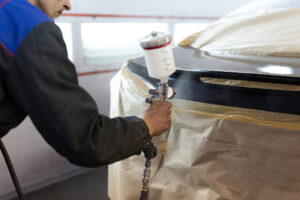
Importance of following OEM refinishing procedures highlighted
By onBusiness Practices | Collision Repair
A BASF automotive expert has shared insights on the challenges of refinishing newer bumpers given the increased complexity and features of modern vehicles.
Jeff Wildman told Repairer Driven News that it’s imperative for everyone in the collision repair industry to review OEM procedures for a vehicle’s make, model, and color when repainting bodies.
When dealing with bumpers, this can be especially critical as some automakers require bumper cover replacement following damage.
For those that are repairable, applying too much paint or failing to follow the refinish manufacturer’s application procedures can reduce the level of radar transmission and impact ADAS features, Wildman said.
Wildman detailed how BASF is working with a number of automakers behind the scenes to test to level of radar reflection and absorption through refinish materials.
“[This includes] different color formulas, to determine if any of the coatings or pigments create a level of radar transmission that reaches an unacceptable level as determined by the OEM,” he said. “In these cases, a color solution may be reformulated with different pigments and a lower the concentration of the aluminum resulting in a radar variant. When repairing bumpers with radar sensors installed behind, it is important to use the radar formulation (OEM approved) when available to help ensure proper radar functionality.”
Wildman said radar systems’ performance can be affected by several factors including bumper material, thickness, and geometry. He added that all layers of coatings applied to the bumper — including the original factory finish — can also influence radar transmission, especially the coatings’ thickness, pigments, metallic content, and dielectric parameters.
“There is no such thing as a simple bumper repair anymore,” Wildman said. “Radar sensors are typically concealed under painted bumper covers, and these sensors ‘see’ through the body panel material and any coatings to perceive the vehicle’s surroundings. To send and receive radar signals correctly, it is critical to have a sufficient degree of transmission while maintaining a low level of reflection.”
Aside from OEM repair procedures, Wildman said it’s important for repair planners and paint shop technicians to follow position statements, paint manufacturers repair procedures and color formations early in the repair process when working with vehicles equipped with radar systems.
He said it’s also important to research the color formula during the repair planning process to determine whether a radar variant is available, and if there are any special toners or finishes that require extra consideration.
“As with any repair, we strongly recommend beginning with a complete repair plan, utilizing the OEM’s repair procedures and paint manufacturers TDS,” Wildman said. “Although often overlooked, it’s becoming more critical to include the paint department in the repair planning process.”
He added: “Many of today’s vehicles include radar sensors located behind a painted panel, such as a bumper, which sometimes limits the collision center’s ability to repair the bumper based on the location, type of damage or vehicle color. This may require bumper cover replacement.”
He also offered some general rules for bumper refinishing:
-
- In cases where a bumper substrate is damaged, scratched, dented or cracked within the radar transmission areas, it should be replaced;
- If you’re only dealing with minor paint damage on a bumper substrate within the radar transmission area, repairs can be done under certain circumstances, depending on the OEM’s repair guidance;
- Do not exceed the recommended number of coats for each paint layer; and
- Coat the radar transmission area evenly to ensure consistent film thickness within the radar beam area. He added that blending within the area is not permitted.
“At the end of the refinishing process the technician should always check to ensure that the radar works properly, and many OEMs also require recalibration of the radar systems and/or operational tests before considering a repair to be completed,” Wildman said.
He added that BASF has worked closely with OEMs for years to test refinish materials to ensure they meet specifications, and that they’re now working with OEMs to test materials for radar transmission with can require reformulation or the development of a radar variant.
“Although we have always worked with OEMs as new colors are developed for color match, we are now getting involved earlier in the color development process, before the color is approved for new vehicles, to ensure that a refinish solution is available that meets all OEM specs, including radar transmission and color match,” Wildman said.
“I have not seen much work being outsourced but I do know shops that are evaluating repairs closer before accepting a repair based on OEM requirements, availability of an approved refinish solution and ability to meet customer expectations.”
During a Collision Industry Conferece panel last month, I-CAR’s director of product management said radar power tests are now being used to ensure the sensors on damaged bumpers are still working as intended if the bumpers were repainted as part of the repair process.
“As an industry we’re starting to go past calibrations,” Nick Dominato said. “In the last year or two we have really started to see all of these extra things you have to do after a calibration.”
Dominato described radar power tests as processes that ensure the capabilities of radar sensor systems haven’t been reduced by overapplication of material during the repainting process.
“The era of a simple bumper job is over,” Dominato said. “We’re just seeing more and more technology.”
Images
Featured image: iStock/Artem Zakharov
Secondary image: CIC panelists (from left) Gary Kilby with Sherwin-Williams, Tracy Fry of AkzoNobel and Jeff Wildman of BASF. (Repairer Driven News/Michelle Thompson)
